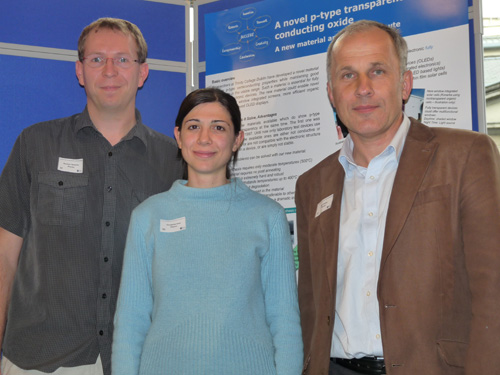Trinity Scientists Discover New Material with Potential to Transform Flat Screen Technology & Solar Cells
Posted on: 17 October 2011
Researchers working in Prof Igor Shvets’ Cleaner Energy Lab, School of Physics and CRANN, funded by Science Foundation Ireland, have discovered a material that could revolutionise flat screen technology and the efficiency of solar cells.
The research, recently published in Applied Physics Letters*, describes the fabrication of a new type of material with the potential to realise advances in devices such as solar cells, flat screen TVs, computer monitors, LCD panels, light emitting diodes and many more. All these devices have one thing in common: they utilise materials that can conduct electricity and at the same time are see-through.

Prof Igor Shvets (right) with Dr Karsten Fleischer and PhD student Elisabetta Arca.
Today industry primarily uses a class of materials called transparent conducting oxides. Such materials are a good compromise between electrical conductivity and optical transparency. One of the most widely used transparent conducting oxides is indium tin oxide. However, all of the most widely used transparent conducting oxides have one fundamental limitation: they all conduct electricity through the movement of electrons. Such materials are referred to as n-type transparent conducting oxides. Electricity can also be conducted through the movement of holes – conceptual particles describing the absence of an electron. These materials are referred to as p-type materials.
Modern day electronics are based on the concept of conduction via electron and holes, i.e. they make use of n-type and p-type materials. The cornerstone on which modern electronics is based, the transistor, is nothing more than a sandwich of n-type and p-type materials.
It was the lack of good quality p-type transparent conducting oxides that lead Prof Shvets, Chair of Applied Physics and his research team to investigate how other oxides could be modified to make them simultaneously electrically conductive and optically transparent. To achieve this aim Prof Shvets brought over 20 years’ experience in conducting oxides to bear on the problem, assisted by his colleague Dr Karsten Fleischer and PhD student Elisabetta Arca.
The new material is based on chromium oxide with the modifications achieved through the simultaneous substituting of some of the chromium and oxygen with magnesium and nitrogen. Finding such a novel material is a testament to the underlying knowledge and research expertise of the team involved and their foresight to realise that screening of elemental substitutions was the key to creating a new p-type transparent conducting oxide.
The new p-type material has the potential to revolutionise transparent conducting oxides and the devices which rely upon them for their operation. The new material could open up the possibility of transparent transistors which could offer fully transparent, window integrated TV screens or the lighting of the future. It could also be used to increase the efficiency of certain solar cells, thus significantly impacting on the take-up of solar cells and resulting in a decrease in greenhouse gas production.
A patent application protecting the new material was filed by Trinity College Dublin. Commenting on the significance and impact of the discovery, Prof Shvets added a cautionary note, saying “it is too early to say for certain that the material will be of industrial use. We first need to fabricate it by means of a growth technique more used by industry, for example, magnetron sputtering.” According to Dr Fleischer, “the discovery opens up a new avenue of modifying other oxides in order to engineer the desired electronic and optical properties. We are hopeful the findings will attract industrial interest.”
*”Magnesium, nitrogen codoped Cr2O3: A p-type transparent conducting oxide”, E. Arca, K. Fleischer, I. V. Shvets, Applied Physics Letters 99, 111910 (2011).
